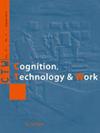印度西孟加拉邦稻农腰痛的人体工程学和社会心理风险因素。
IF 3.4
3区 工程技术
Q2 ENGINEERING, INDUSTRIAL
引用次数: 2
摘要
水稻种植被认为是印度最重要的产业,印度有数百万农民患有LBP。本研究的主要目的是评估印度稻农腰痛的患病率,并确定腰痛与农民遇到的人体工程学危险因素和社会心理因素之间的关系。方法分析水稻农户腰痛的社会人口学、工效学危险因素和社会心理因素。采用改良的北欧肌肉骨骼问卷和Oswestry腰痛问卷对农民进行腰痛评估。进行单因素分析,找出农民之间的优势比和95%置信区间。结果社会心理因素与LBP的关系主要有收入感知不足(84.7%)、工作需求(78.1%)、工作需求目标特定生产率(76.5%)、工作方法僵化(75.3%)、工作单调(73.2%)。结果还揭示了腰痛与人体工程学危险因素之间的关系,如重复性(OR- 4.215;95% CI- 2.551-6.965),以尴尬的姿势工作(OR- 85.82;95% CI- 43.134-170.77),起重负荷(OR- 0.281;95% CI- 0.125-0.324),牵引负荷(OR- 0.274;95% CI- 0.173-0.434),在单因素分析中显示与LBP有显著关系。结论稻农腰痛患病率与工效学和社会心理危险因素有关。姿势不当、抬抬是导致腰痛的主要原因。本文章由计算机程序翻译,如有差异,请以英文原文为准。
Ergonomic and psychosocial risk factors for low back pain among rice farmers in West Bengal, India.
BACKGROUND
Rice farming is considered the most crucial industry in India, where millions of farmers suffer from LBP.
OBJECTIVES
The present study's primary objectives were to evaluate the prevalence of low back pain among India's rice farmers and determine the relationship between low back pain and ergonomic risk factors and psychosocial factors encountered by the farmers.
METHODS
Socio-demographics, ergonomics risk factors and psychosocial factors that cause LBP among rice farmers were examined. Modified Nordic Musculoskeletal Questionnaire and Oswestry LBP Questionnaire were administered among the farmers to evaluate the LBP. Univariate analysis was done to find out the odds ratios and 95% confidence intervals among the farmers.
RESULTS
The primary findings from this study regarding the psychosocial factors, such as perceived inadequacy of income (84.7% ), job demands (78.1% ), work demand targets specific productivity (76.5% ), rigidity in work methods (75.3% ), monotony at work (73.2 % ), have a relationship with LBP. The results also revealed that the relationship between the low back pain and ergonomic risk factors, such as repetitiveness (OR- 4.215; 95% CI- 2.551-6.965), working in awkward posture (OR- 85.82; 95% CI- 43.134-170.77), lifting loads (OR- 0.281; 95% CI- 0.125-0.324), pulling loads (OR- 0.274; 95% CI- 0.173-0.434), showed significant relationship with LBP in the univariate analysis.
CONCLUSIONS
The prevalence of LBP among rice farmers connected with ergonomic and psychosocial risk factors. The awkward posture, MMH (lifting and carrying) are the main causative factors of LBP.
求助全文
通过发布文献求助,成功后即可免费获取论文全文。
去求助
来源期刊

Cognition Technology & Work
ENGINEERING, INDUSTRIAL-
CiteScore
6.90
自引率
7.70%
发文量
26
审稿时长
>12 weeks
期刊介绍:
Cognition, Technology & Work focuses on the practical issues of human interaction with technology within the context of work and, in particular, how human cognition affects, and is affected by, work and working conditions.
The aim is to publish research that normally resides on the borderline between people, technology, and organisations. Including how people use information technology, how experience and expertise develop through work, and how incidents and accidents are due to the interaction between individual, technical and organisational factors.
The target is thus the study of people at work from a cognitive systems engineering and socio-technical systems perspective.
The most relevant working contexts of interest to CTW are those where the impact of modern technologies on people at work is particularly important for the users involved as well as for the effects on the environment and plants. Modern society has come to depend on the safe and efficient functioning of a multitude of technological systems as diverse as industrial production, transportation, communication, supply of energy, information and materials, health and finance.
 求助内容:
求助内容: 应助结果提醒方式:
应助结果提醒方式:


